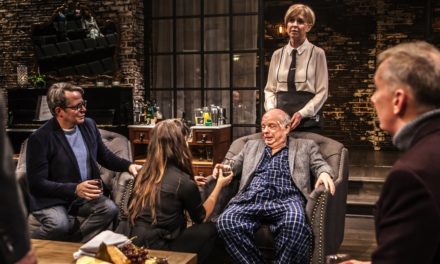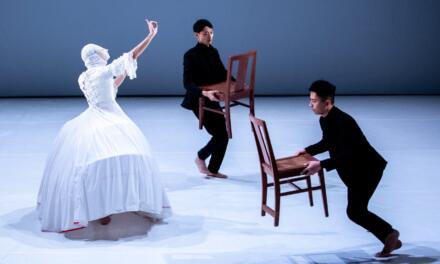It is the second time that Los números imaginarios (The imaginary numbers), a Spanish company of collaborative and immersive theater, call for artistic residencies. Six projects have been selected and the results have been shown in El Umbral de Primavera, an alternative theater in the trendy neighborhood of Lavapiés (Madrid) in April.
What do the six projects have in common? All of them are plays that are built collaboratively by the whole crew members of each one. In addition, they try to involve the audience in the stage fact instead of treating them as passive spectators who are sitting down to be told a story, yet another one.
Then, how did they try to involve the public? They did before audiences were placed in their seats. Every play has a specific performative introduction in the big lobby of this small theater whose atmosphere looks like El Rastro, the Sunday traditional and popular flea market in Madrid.
The purpose of these performative actions is that the spectators left their petty or big problems apart and focus on the show that they have gone to see. It was usually done with thoughtful quizzes or stories that were told to small groups by crew members, but not always.
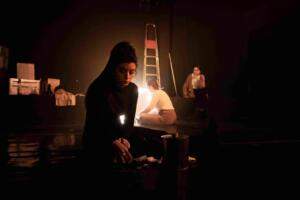
Sing and do not cry. PC: Cristina Bravo.
That was the case of Canta y no llores (Sing and do not cry) by Elena Santos. The foyer became a discotheque. There is a DJ who plays popular songs to make audiences sing and dance, while the cast is working around as waitresses, housekeepers, or go-go dancers. It was one of those sleazy bars that are found on the outskirts where plenty of people who are drunk and hooked are looking for a casual sex partner to deal with their non-satisfactory lives.
However, inside the theater, when people were sitting, the play would show them the beastly backstage of the party. Three young women whose work perspectives are reduced to serving drinks in a nightclub and putting up with drunken customers who flirt with them. And their personal targets are reduced to quick sexual intercourse in restrooms, a brief break for a ham and cheese sandwich, some drinks and/or drugs, and, perhaps, a boyfriend waiting for them at home. The B-side of the rich Europe, most common in its southern touristic destinations, like Andalucía the place where this company comes from.
No differences are between North and South of Spain. Tragantona (Big swallowing) by Irati Morán is a story from Basque Country in which four young people without any perspective joined in a ceremony for recovering the feeling of community that their grandparents and parents had. They try during a meal, being seated in a specific place at the table and following a detailed order of dishes according to a pattern previously decided and close to Basque traditions or their personal stories. That one had been one of the most bizarre experiences of the festival. This play is close to all the best arty movies about food, like La grande bouffe by Marco Ferreri or Babette’s Feast by Gabriel Axe.

La covancha by Maite Barrera.
Food and memories of the past are also the linkers of La covancha (a title that does not have a translation into English) by Maite Barrera. It is starred by two excellent actors, Irene Serrano and Jesús Barranco, who frequently are in the cast of productions of Spanish National Theater. Both performers managed to bring the audience into the playwright’s village while the audience baked their grandmother’s doughnuts. Doughnuts that they ate at the end when crew members met the audience in the lobby and had a small talk about what memories of their villages they lived in or went to in summers.
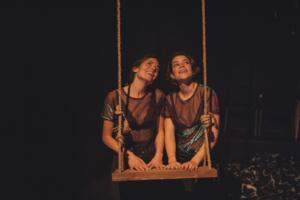
Abyssalis. Photo by Maykiso.
Abyssalis by Patricia Peñalver is based on memories too. A play that recalls and revisits an old lesbian relationship that has not yet been forgotten. It is a poetic duet for two actresses that occurs in an unfathomable sea. A cold lonesome place inhabited by jellyfish and abyssal and phosphorescent fish. The scenery is so pretty that nothing prepares you for what you will see on stage. However, the most astonishing was the result of the quiz that was done before the performance. They asked about fears and the fear of being alone won by a landslide. The same fear that both characters have in the play, the source of their suffering.
The fear of being alone is the motto of the main character of Interior: Día (Inside: Day) by Miguel Valentin. It is the story of a straight film scriptwriter in his last thirties who breaks up with his fiancée. A funny personal and professional crisis with a tragic but somehow apt end starred by Luis Sorolla, another renowned young Spanish actor, director, and playwright. A play that is full of projections that are being recording during the performance. A metaphor for the fragmented and fragile life of the main character.
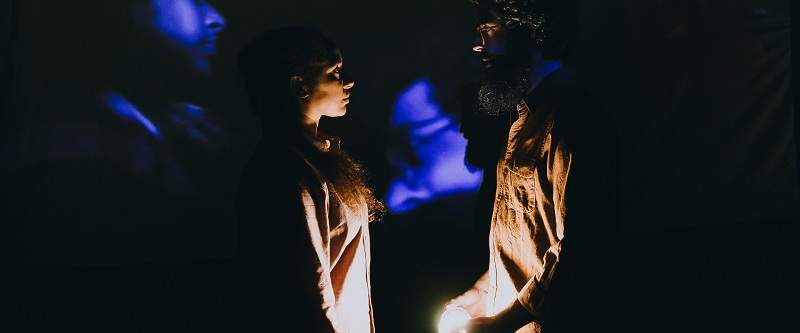
Inside Day by Miguel Valentin. PC: Luz Soria.
Last, but not least, Cómo ser Cleopatra. Un estudio sobre la tentación y sobre cómo perder Egipto en 10 pasos (How to be Cleopatra. A study on temptation and how to lose Egypt in 10 steps) was the feminist play of the festival. It is an amusing one that begins with a quick summary and analysis of Antonio and Cleopatra by Shakespeare to define ten steps to be empowered in our society.
Steps that the cast put into practice during the show leading by the example in different scenes. Such as the way that one of the actress deal with her compulsion for candies. The play suggests that Cleopatra must be a role model for women and men in our equity times and societies. Everybody should be prone to feel and act as this queen did in Egypt and Rome in ancient times. It is a moral and social challenge that will become a big change for individuals and for societies.
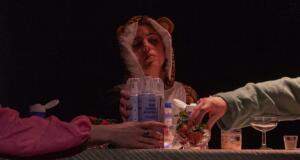
How to be Cleopatra. A study on temptation and how to lose Egypt in 10 steps
In all those six plays, the public is usually asked to participate in different ways during the performance but not as far as in Leviatan by Luis Sorolla. This one is a step beyond immersive and collaborative theater because spectators were privately invited by Los Números Imaginarios. The play is not included in the program of the festival. It is hidden and I am breaking the confidence telling in this article.
This piece could be described as do-it-yourself theater (DIY theater) and it is the kind of experiment that these companies like to propose to their audiences. Every person who is invited to Leviatan is given an envelope when they arrive at the theater. Inside the envelope, they found instructions for letting them set and perform their own play. A piece is about a person who is swallowed by a whale. The spectator, who is the crew too, had to give the whale a name, choose between different options for the scenes, and build their own scenery and end. That was meant, that the public became the stage director, the set designer, and the cast of the play. They had to assume any role in the production. Furthermore, they were who collected all the material in the envelope when they finished and went out of the theater without making any noise, not disturbing the rest of the people, without even applauding themselves for their performance.
It is because of all that has been told that this festival should spin as it has been presented in El Umbral de Primavera. Scheduling it from Thursday to Sunday in different cities or towns or included within a longer festival as a new theatrical trend. It would be a good way to promote theater among young people since one of the most striking facts of Abril imaginario has been that young people predominated among the audience. And, as everyone knows, the youngsters are the ones who guarantee the future of theater one step beyond.
Edited by Nicholas Dale Leal
This post was written by the author in their personal capacity.The opinions expressed in this article are the author’s own and do not reflect the view of The Theatre Times, their staff or collaborators.
This post was written by Antonio Hernández Nieto.
The views expressed here belong to the author and do not necessarily reflect our views and opinions.


